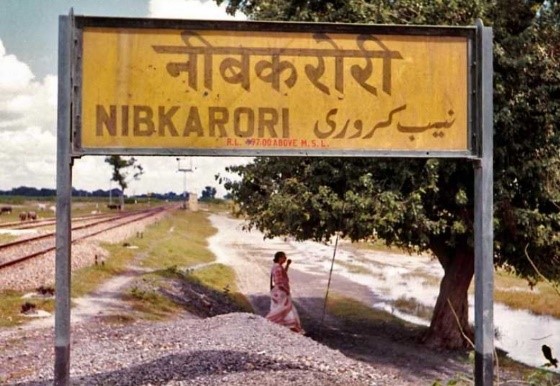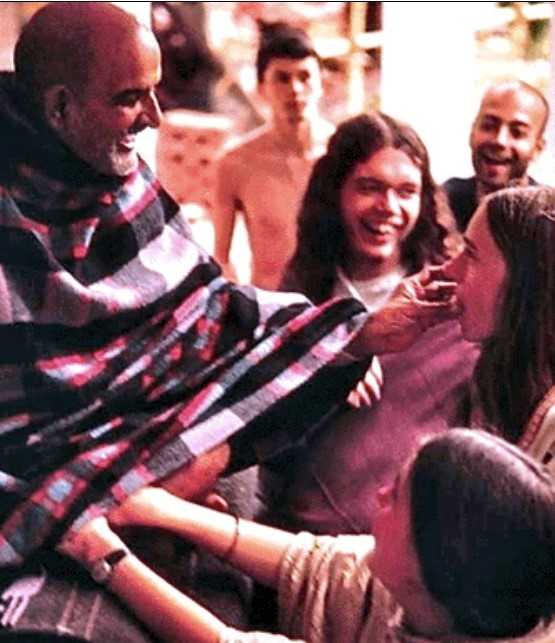“Ek, Ek, Ek” The Oneness of Ignorance
As we have learned in Chapter Eight of this expose, “Whoever describes Vedic knowledge as impersonal is a demon.” (Madhya-lila 17.104). Demons are called asuras. Despite such admonitions, The Journey Home is an un-Godly utsava of oneness, a pathetic parade of Mayavada, and a phantasmagorical festival of impersonalism. It is full of demonic discourses of hackneyed and hokey half-truths. This affront to genuine Vaishnava dharma is nowhere more evident than in Radhanatha’s exchanges with the well-known Mayavadi Neem Karoli Baba, whom the book describes as a Siddha Purusha—a “perfected being.”
 Neem Karoli Baba, who died at 73 in 1973, lived in Vrindavana During the 60’s and early 70’s. He was popular among the hippie American Mayavadi set for the simple reason that he required of his “students” neither regulative principles nor genuine Vedic understanding. Since “all is one” blind adoration is sufficient for one impersonalist after another who repeats this formula to capture simpletons in their webs of ignorance.
Neem Karoli Baba, who died at 73 in 1973, lived in Vrindavana During the 60’s and early 70’s. He was popular among the hippie American Mayavadi set for the simple reason that he required of his “students” neither regulative principles nor genuine Vedic understanding. Since “all is one” blind adoration is sufficient for one impersonalist after another who repeats this formula to capture simpletons in their webs of ignorance.
Legend says that his name Neem Karoli Baba came from an incident wherein as a wandering sadhu he was kicked off a train at a tiny village called Neeb Karori. But then mysteriously the train would not move until the Baba was allowed to return to his seat. But he only agreed to get back on the train and allow it to run again if the government would build a station at that spot. And lo and behold, the Indian railways built the station there and everyone lived happily ever after. So that is how he came to be known as Neem Karoli.. For India is a land of mythological bunk and legendary balderdash that can turn sly, lazy men who want to live off others into avataras, incarnations and siddha purushas. At least for the Mayavadis this once spiritual oasis has become a land of colorless and contrived hokum; fables that make ordinary men into overnight avatara simply to fool others and cheat them.
Radhanatha waxes eloquently on page 252 of The Journey Home that a man approached him exclaiming that Neem Karoli Baba knew all about him and wanted to have his darshan. Next …
“Seeing me, (Neem Karoli Baba) broke into a contagious smile and welcomed me … He seemed to know everything about me and spoke just the words I needed to hear. I was both charmed and amazed. …
“One day (Neem Karoli Baba) turned to me, his eyes seeming to search my soul. Then shooting up a single finger, he exclaimed ‘Ek, Ek Ek, God is One.’”

“All religions are the same. They lead to God. God is everybody …” – Neem Karoli Baba from Miracle of Love
The imaginary oneness that Mayavadis like Neem Karoli Baba and other well-worn philosophers of his ilk pretend to have realized is clearly explained in Shri Ishopanishad. Shrila Prabhupada presented Shri Ishopanishad as a very basic introduction into the higher texts of Krishna consciousness. It serves as an introduction even to Bhagavad-gita As It Is, which is the foundation and basis of the Krishna consciousness movement. Shri Ishopanishad is quite simply the book that in nineteen mantras takes one out of mere impersonalism into the awakening of the understanding that the Supreme Lord has form, features, personality, associates, and a supreme identity.
Although it is true that “God is One,” the other side of the philosophical jigsaw puzzle is that “God is also different.” And when a so-called disciple of Shrila Prabhupada and the Gaudiya sampradaya fails to explain in his writings this concept of achintya beda-abeda tattwa—simultaneously and inconceivable one and different—then he is guilty of misleading the readers. And this means taking them down to hell, for as Shri Ishopanishad states right up front in Mantra Three:
asuryā nāma te lokāandhena tamasāvṛtāḥ
tāṁs te pretyābhigacchantiye ke cātma-hano janāḥ
“The killer of the soul whoever he may be, must enter into the planets known as the worlds of the faithless full of darkness and ignorance.”
In this verse impersonalists are described as atma-hanah or “killers of the soul.” These misguided atma-hanas are condemned after death (“in the preta or subtle body”) to enter a place that has been reserved for asuras or demons (asurya). This is a region of hell that is andhena or “filled with ignorance” (andha or “blindness”) and darkness (tamasa or ignorance). The meaning is very clear, and the reasoning of Shri Ishopanishad becomes clearer still as the reader progresses through the verses.
This region of ignorance (andhena tamasāvṛtāḥ) is further described as Andha-tāmisraḥ in the 5th canto of Shrimad-Bhagavatam, chapter 26 (verse 9), entitled “A Description of the Hellish Planets.”
“The destination of a person who slyly cheats another man and enjoys his wife and children is the hell known as Andhatāmisra. There his condition is exactly like that of a tree being chopped at its roots. Even before reaching Andhatāmisra, the sinful living being is subjected to various extreme miseries. These afflictions are so severe that he loses his intelligence and sight. It is for this reason that learned sages call this hell Andhatāmisra.”
The idea of this verse is that it is a place for cheaters. Those who spread ignorance so that they can exploit them for money and imaginary position are brought to this place of andha—constant blackness. It is said to be like an andha kupa, a dark well because due to the punishments suffered on the way to this hell both intelligence and sight are lost. One who finds himself stuck for a long period in this hell called Andhatamisra wanders in pitch darkness aimlessly unaware of where he is or where is going. He suffers constantly in that awful place.

Demonic activities of a dishonest poser
https://harekrsna.com/sun/editorials/06-14/editorials11840.htm
Neem Karoli Baba lived in Vrindavana, the land of Krishna. Yet for his own self-aggrandizement he had the audacity to attract disciples through preaching of some impersonal, demonic concept of an imaginary “God” and not the all-attractive Murlidhara. This form of deception is not much appreciated by the Supreme Lord anywhere, what to speak of in His own Supreme Abode of Vrindavana.
Since Mayavadis like to think that “all religions are one,” they may like to know that all of them also include hell in their teachings as seen here: https://en.wikipedia.org/wiki/Hell. Conviction to the impersonal doctrine should mean that that since it is “all one” (or Eke Ek Ek), then the Mayavadi should be content just go to hell and live in the oneness of Andhatamishra.